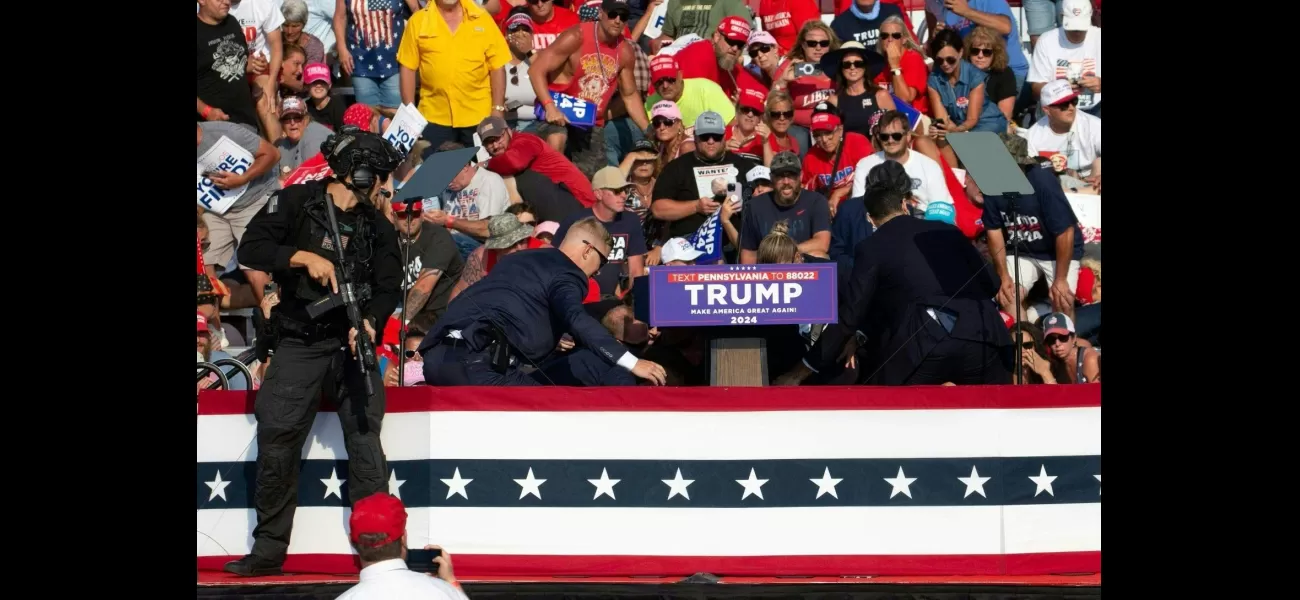A look at the history of assassinations of US presidents, including the use of grenades and attacks from grassy knolls.
14 US presidents and candidates have been targeted for assassination, with Donald Trump being the most recent.
July 14th 2024.

Donald Trump is now part of a small but unfortunate group of 14 US presidents and candidates who have faced assassination attempts. This Sunday morning, the world was shaken by the sight of a wounded Trump being carried away by his bodyguards at a rally in Pennsylvania. The former president and current presidential candidate had been hit by bullets fired by a lone gunman from a nearby rooftop. Tragically, one attendee was killed and two others were critically injured.
The shooter has been identified as Thomas Matthew Crooks, a 20-year-old registered Republican voter who was shot by the US Secret Service operatives assigned to protect Trump. At this early stage in the investigation, details about Crooks' motives are scarce, but social media is already filled with conspiracy theories and speculation. Leaders from around the world have expressed shock and concern about this incident, as it appears to reflect a disturbing shift in the US political landscape. Despite this, Trump has vowed to continue his campaign and is scheduled to make public appearances next week.
Trump now joins a list of 13 other US presidents and candidates who have also faced assassination attempts, with five of them resulting in death. For those who are not familiar with American political history, here is a brief summary of the past attempts on presidents' lives. The first attempt on a US president's life was made on Andrew Jackson in 1835, as he was leaving the Capitol building in Washington, DC. The attacker, Richard Lawrence, an unemployed house painter, aimed a pistol at Jackson but it jammed. Jackson then hit Lawrence with his walking stick, and he was later found not guilty by reason of insanity.
Abraham Lincoln, who had issued the Emancipation Proclamation during the Civil War, was shot while attending a theatre with his wife in 1865. He sustained a gunshot wound to the back of the head but miraculously remained alive until the next morning. The shooter, John Wilkes Booth, a stage actor and Confederate sympathizer, was found and killed 12 days later. James Garfield became the second US president to be assassinated in 1881, when he was shot by Charles Guiteau, an aspiring political opponent. Garfield survived for several weeks before succumbing to his injuries, and Guiteau was executed for his crime the following year.
In 1901, William McKinley was shot twice in the chest while greeting the crowd after a speech in Buffalo, New York. He initially had a high chance of recovery, but he eventually died from gangrene that had formed around his wounds. The shooter, Leon Czolgosz, was an anarchist who was executed a month after McKinley's death. Theodore Roosevelt, who was running for a third term as president, was shot at in 1912, but luckily, a bundle of papers and a glasses case in his pocket helped deflect the bullets. The shooter, John Schrank, was found to be insane and spent the rest of his life in an institution. In 1933, Franklin D. Roosevelt survived a shooting in Miami, but unfortunately, the incident resulted in the death of Chicago Mayor Anton Cermak.
These are just a few examples of the 14 assassination attempts on US presidents and candidates over the past 160 years. It is a small but significant part of American political history that serves as a reminder of the dangers that come with public service. Let us hope that incidents like this will become a thing of the past, and that our leaders can continue their important work without fear of harm.
On a typical Sunday morning, the world was shocked by the images of a bloodied Donald Trump being escorted away from a rally in Pennsylvania by his bodyguards. The former president and now-presidential candidate had been grazed by bullets fired from a nearby rooftop, tragically resulting in the death of one attendee and severe injuries to two others.
The culprit, 20-year-old Thomas Matthew Crooks, was a registered Republican voter who was immediately killed by the US Secret Service operatives tasked with protecting Trump. As the investigation into the shooting continues, details about Crooks' motives are still scarce and the spread of conspiracy theories and speculation on social media only adds to the confusion.
Leaders from around the world have expressed their shock and concern over this alarming event, which seems to be a concerning shift in the US political landscape. Despite this, Trump remains determined to continue with his campaign and has even scheduled public appearances for next week. This makes him the latest addition to the list of 14 US presidents and candidates who have faced assassination attempts over the past 160 years.
For those of us who may not be familiar with American political history, here's a quick reminder of the previous attempts on US presidents' lives. Out of the 14 attempts, five have sadly been fatal. The first recorded attempt was on President Andrew Jackson in 1835, as he was leaving the Capitol building in Washington, DC. He was approached by an unemployed house painter named Richard Lawrence, who aimed a pistol at him. However, both of Lawrence's pistols misfired, and Jackson even managed to hit him with his walking stick before he was subdued by his bodyguards. Lawrence was later found not guilty by reason of insanity and spent the rest of his life in a mental institution.
Abraham Lincoln, who famously issued the Emancipation Proclamation, was shot while attending a theatre with his wife in 1865. He was hit in the back of the head by John Wilkes Booth, a stage actor and Confederate sympathizer. Although Lincoln miraculously remained alive until the next morning, he ultimately succumbed to his injuries. Booth was found and killed by Union soldiers 12 days later.
The next assassination occurred in 1881 when President James Garfield was shot by Charles Guiteau, an aspiring political opponent. Garfield was hit twice and died several weeks later, while Guiteau was executed for his crime the following year. President William McKinley was also shot twice in 1901, after delivering a speech in New York. He initially had a high chance of recovery, but ultimately died from gangrene caused by his wounds. The shooter, Leon Czolgosz, was executed by electric chair the following month.
In 1912, Theodore Roosevelt, who was running for a third term as president, was shot at while getting into a car. Luckily, he was saved by a bundle of papers and a glasses case in his pocket, which helped to dull the bullets' impact. The culprit, John Schrank, was found to be insane and spent the rest of his life in an institution. Finally, in 1933, Franklin D. Roosevelt became the third president to survive an assassination attempt. He was unharmed, but the shooting claimed the life of Chicago Mayor Anton Cermak.
As we reflect on these disturbing events, it's clear that the safety of our political leaders is of utmost importance. Let us hope that we can learn from the past and prevent such tragedies from occurring in the future.
The shooter has been identified as Thomas Matthew Crooks, a 20-year-old registered Republican voter who was shot by the US Secret Service operatives assigned to protect Trump. At this early stage in the investigation, details about Crooks' motives are scarce, but social media is already filled with conspiracy theories and speculation. Leaders from around the world have expressed shock and concern about this incident, as it appears to reflect a disturbing shift in the US political landscape. Despite this, Trump has vowed to continue his campaign and is scheduled to make public appearances next week.
Trump now joins a list of 13 other US presidents and candidates who have also faced assassination attempts, with five of them resulting in death. For those who are not familiar with American political history, here is a brief summary of the past attempts on presidents' lives. The first attempt on a US president's life was made on Andrew Jackson in 1835, as he was leaving the Capitol building in Washington, DC. The attacker, Richard Lawrence, an unemployed house painter, aimed a pistol at Jackson but it jammed. Jackson then hit Lawrence with his walking stick, and he was later found not guilty by reason of insanity.
Abraham Lincoln, who had issued the Emancipation Proclamation during the Civil War, was shot while attending a theatre with his wife in 1865. He sustained a gunshot wound to the back of the head but miraculously remained alive until the next morning. The shooter, John Wilkes Booth, a stage actor and Confederate sympathizer, was found and killed 12 days later. James Garfield became the second US president to be assassinated in 1881, when he was shot by Charles Guiteau, an aspiring political opponent. Garfield survived for several weeks before succumbing to his injuries, and Guiteau was executed for his crime the following year.
In 1901, William McKinley was shot twice in the chest while greeting the crowd after a speech in Buffalo, New York. He initially had a high chance of recovery, but he eventually died from gangrene that had formed around his wounds. The shooter, Leon Czolgosz, was an anarchist who was executed a month after McKinley's death. Theodore Roosevelt, who was running for a third term as president, was shot at in 1912, but luckily, a bundle of papers and a glasses case in his pocket helped deflect the bullets. The shooter, John Schrank, was found to be insane and spent the rest of his life in an institution. In 1933, Franklin D. Roosevelt survived a shooting in Miami, but unfortunately, the incident resulted in the death of Chicago Mayor Anton Cermak.
These are just a few examples of the 14 assassination attempts on US presidents and candidates over the past 160 years. It is a small but significant part of American political history that serves as a reminder of the dangers that come with public service. Let us hope that incidents like this will become a thing of the past, and that our leaders can continue their important work without fear of harm.
On a typical Sunday morning, the world was shocked by the images of a bloodied Donald Trump being escorted away from a rally in Pennsylvania by his bodyguards. The former president and now-presidential candidate had been grazed by bullets fired from a nearby rooftop, tragically resulting in the death of one attendee and severe injuries to two others.
The culprit, 20-year-old Thomas Matthew Crooks, was a registered Republican voter who was immediately killed by the US Secret Service operatives tasked with protecting Trump. As the investigation into the shooting continues, details about Crooks' motives are still scarce and the spread of conspiracy theories and speculation on social media only adds to the confusion.
Leaders from around the world have expressed their shock and concern over this alarming event, which seems to be a concerning shift in the US political landscape. Despite this, Trump remains determined to continue with his campaign and has even scheduled public appearances for next week. This makes him the latest addition to the list of 14 US presidents and candidates who have faced assassination attempts over the past 160 years.
For those of us who may not be familiar with American political history, here's a quick reminder of the previous attempts on US presidents' lives. Out of the 14 attempts, five have sadly been fatal. The first recorded attempt was on President Andrew Jackson in 1835, as he was leaving the Capitol building in Washington, DC. He was approached by an unemployed house painter named Richard Lawrence, who aimed a pistol at him. However, both of Lawrence's pistols misfired, and Jackson even managed to hit him with his walking stick before he was subdued by his bodyguards. Lawrence was later found not guilty by reason of insanity and spent the rest of his life in a mental institution.
Abraham Lincoln, who famously issued the Emancipation Proclamation, was shot while attending a theatre with his wife in 1865. He was hit in the back of the head by John Wilkes Booth, a stage actor and Confederate sympathizer. Although Lincoln miraculously remained alive until the next morning, he ultimately succumbed to his injuries. Booth was found and killed by Union soldiers 12 days later.
The next assassination occurred in 1881 when President James Garfield was shot by Charles Guiteau, an aspiring political opponent. Garfield was hit twice and died several weeks later, while Guiteau was executed for his crime the following year. President William McKinley was also shot twice in 1901, after delivering a speech in New York. He initially had a high chance of recovery, but ultimately died from gangrene caused by his wounds. The shooter, Leon Czolgosz, was executed by electric chair the following month.
In 1912, Theodore Roosevelt, who was running for a third term as president, was shot at while getting into a car. Luckily, he was saved by a bundle of papers and a glasses case in his pocket, which helped to dull the bullets' impact. The culprit, John Schrank, was found to be insane and spent the rest of his life in an institution. Finally, in 1933, Franklin D. Roosevelt became the third president to survive an assassination attempt. He was unharmed, but the shooting claimed the life of Chicago Mayor Anton Cermak.
As we reflect on these disturbing events, it's clear that the safety of our political leaders is of utmost importance. Let us hope that we can learn from the past and prevent such tragedies from occurring in the future.
[This article has been trending online recently and has been generated with AI. Your feed is customized.]
[Generative AI is experimental.]
0
0
Submit Comment





